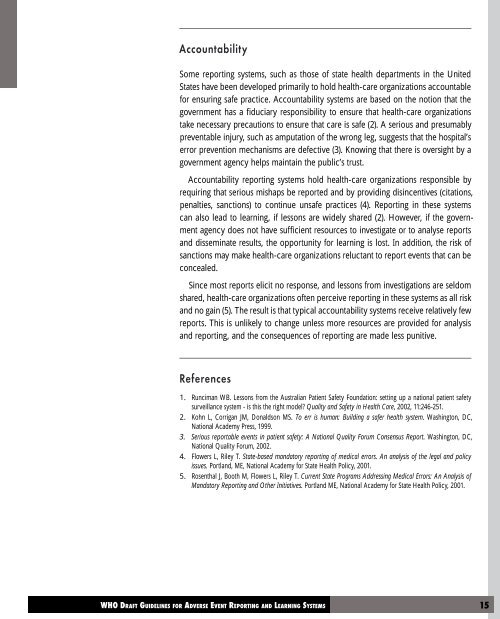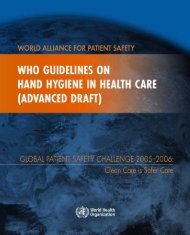Adverse event reporting.pdf
Adverse event reporting.pdf
Adverse event reporting.pdf
You also want an ePaper? Increase the reach of your titles
YUMPU automatically turns print PDFs into web optimized ePapers that Google loves.
Accountability<br />
Some <strong>reporting</strong> systems, such as those of state health departments in the United<br />
States have been developed primarily to hold health-care organizations accountable<br />
for ensuring safe practice. Accountability systems are based on the notion that the<br />
government has a fiduciary responsibility to ensure that health-care organizations<br />
take necessary precautions to ensure that care is safe (2). A serious and presumably<br />
pr<strong>event</strong>able injury, such as amputation of the wrong leg, suggests that the hospital’s<br />
error pr<strong>event</strong>ion mechanisms are defective (3). Knowing that there is oversight by a<br />
government agency helps maintain the public’s trust.<br />
Accountability <strong>reporting</strong> systems hold health-care organizations responsible by<br />
requiring that serious mishaps be reported and by providing disincentives (citations,<br />
penalties, sanctions) to continue unsafe practices (4). Reporting in these systems<br />
can also lead to learning, if lessons are widely shared (2). However, if the government<br />
agency does not have sufficient resources to investigate or to analyse reports<br />
and disseminate results, the opportunity for learning is lost. In addition, the risk of<br />
sanctions may make health-care organizations reluctant to report <strong>event</strong>s that can be<br />
concealed.<br />
Since most reports elicit no response, and lessons from investigations are seldom<br />
shared, health-care organizations often perceive <strong>reporting</strong> in these systems as all risk<br />
and no gain (5). The result is that typical accountability systems receive relatively few<br />
reports. This is unlikely to change unless more resources are provided for analysis<br />
and <strong>reporting</strong>, and the consequences of <strong>reporting</strong> are made less punitive.<br />
References<br />
1.<br />
2.<br />
3.<br />
4.<br />
5.<br />
Runciman WB. Lessons from the Australian Patient Safety Foundation: setting up a national patient safety<br />
surveillance system - is this the right model? Quality and Safety in Health Care, 2002, 11:246-251.<br />
Kohn L, Corrigan JM, Donaldson MS. To err is human: Building a safer health system. Washington, DC,<br />
National Academy Press, 1999.<br />
Serious reportable <strong>event</strong>s in patient safety: A National Quality Forum Consensus Report. Washington, DC,<br />
National Quality Forum, 2002.<br />
Flowers L, Riley T. State-based mandatory <strong>reporting</strong> of medical errors. An analysis of the legal and policy<br />
issues. Portland, ME, National Academy for State Health Policy, 2001.<br />
Rosenthal J, Booth M, Flowers L, Riley T. Current State Programs Addressing Medical Errors: An Analysis of<br />
Mandatory Reporting and Other Initiatives. Portland ME, National Academy for State Health Policy, 2001.
















